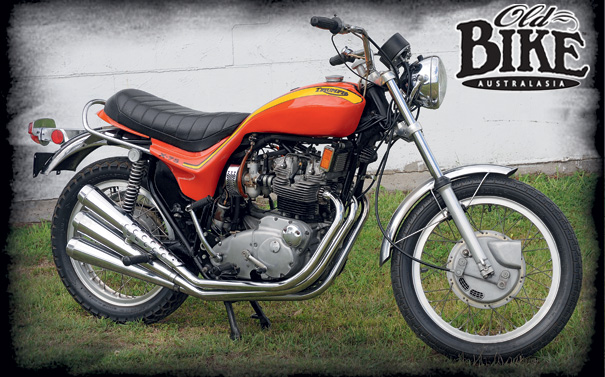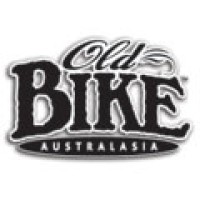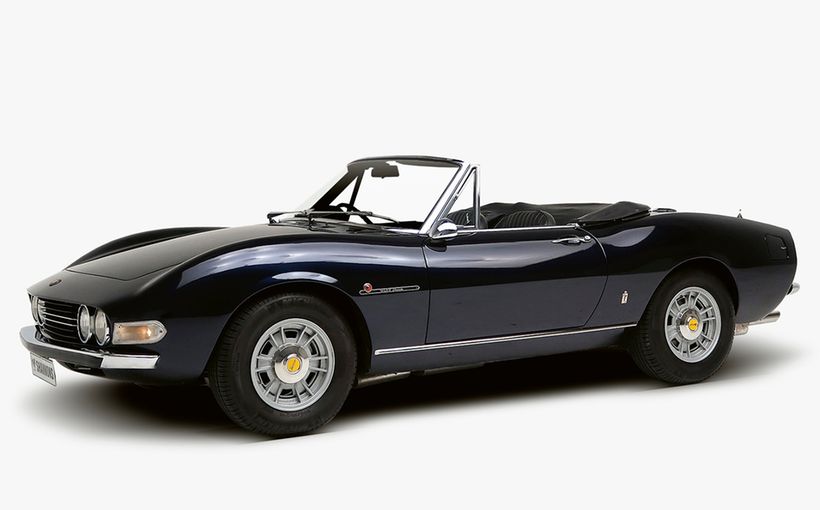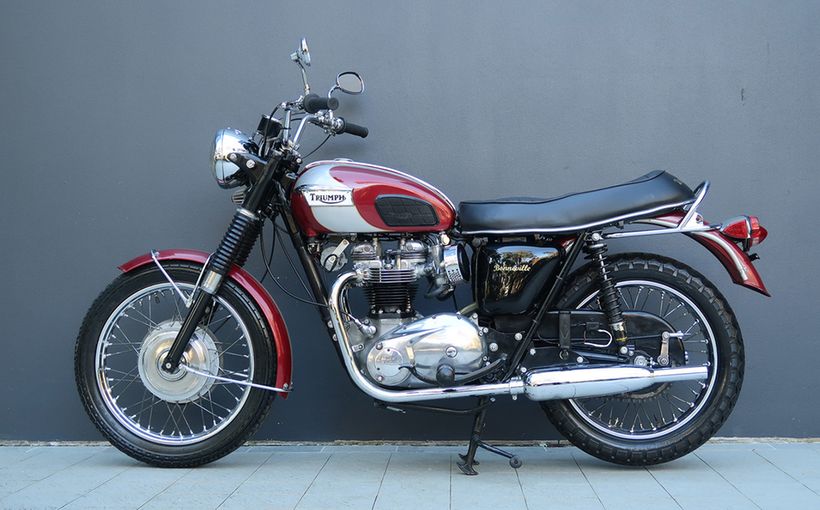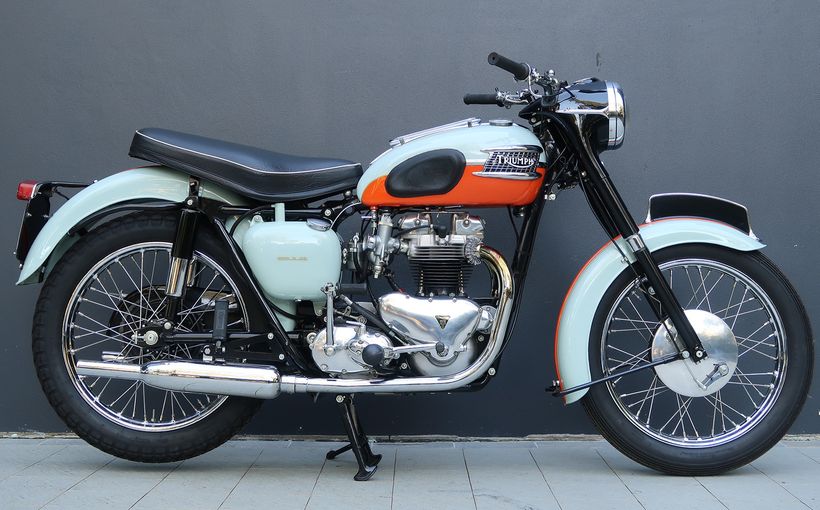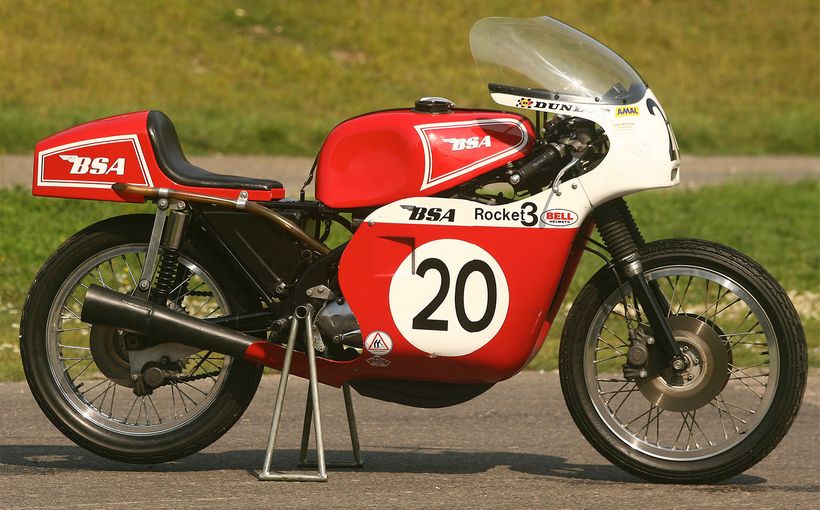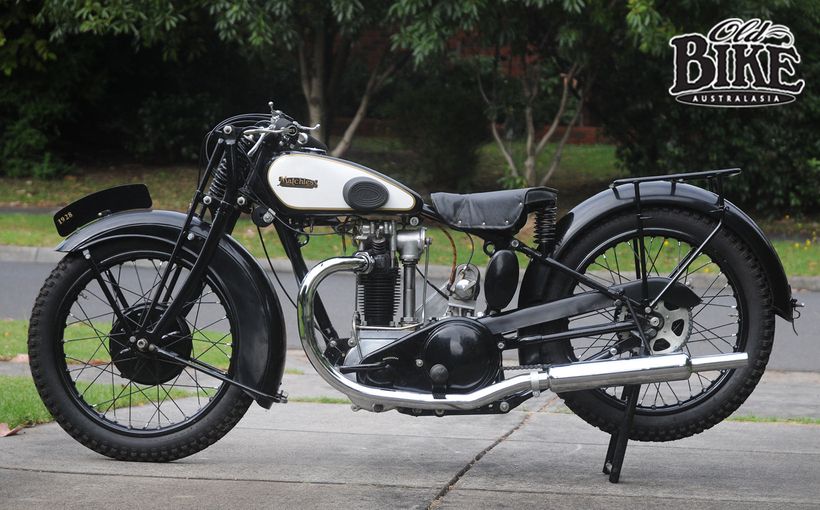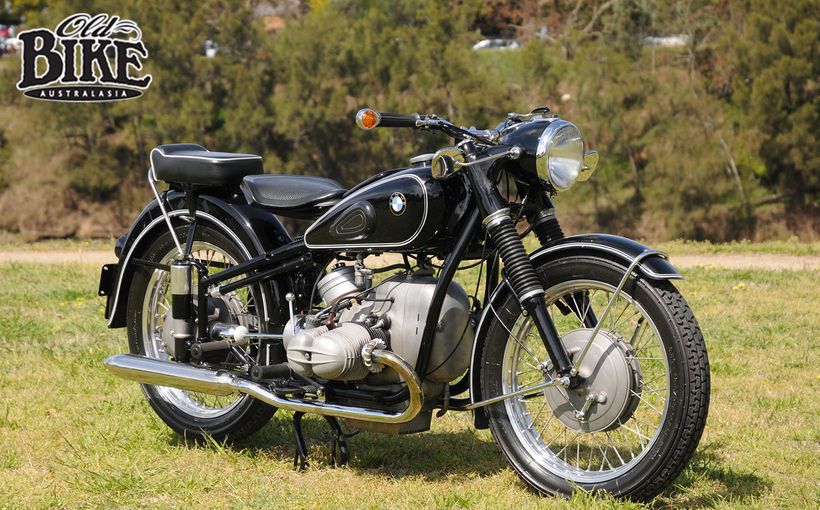Old Bike Australasia: Triumph Hurricane - Triumph 75

BSA had been lurching from one disaster to another for more than a decade, with declining home sales and continuing industrial rows, but still enjoyed a loyal customer base in the US. By late 1968, BSA/Triumph were finally ready to launch their three-cylinder superbike, marketed as the Rocket 3, or A75 in BSA guise, and as the T150 Trident in Triumph livery. For reasons known only to the boffins in charge of the group, the two machines, although basically similar, were quite different, which meant different tooling for what was supposed to have been a badge-engineering job. The BSA’s engine had the cylinders slanted forward by about 15-degrees, while the Triumph’s were vertical. The frames were also quite different, particularly at the rear end. The pushrod engine used a 120-degree crankshaft that gave a very smooth power delivery (and a distinctive exhaust note), but both machines were heavy and had poor ground clearance. Crucially, they also cost more than the sensational new Honda CB750, which had refinements such as an overhead camshaft four-cylinder engine with electric starter, front disc brake and a five-speed gearbox.
BSA ceased production in 1971, the Rocket 3 having been dropped the previous year, while the Trident soldiered on until 1975, receiving a major face lift in 1972 with a five-speed transmission and disc front brake, with an electric starter added in 1974. Across the Atlantic, the BSA Rocket 3 had been a disappointment in the sales race, clearing only 1,800 units in its first sales year. Don Brown, Vice President and General Manager of BSA Inc, based in Nutley, New Jersey, decided to do something about it. Brown had an impressive background in motorcycling, having been editor of Cycle Magazine in the 1950s and later Sales Manager at Johnson Motors (Triumph) and National Director of Operations at US Suzuki. He joined BSA Inc, in 1967.
In early 1969 Brown, along with other US BSA/Triumph executives travelled to UK to see the new triples, and several aspects did not impress them, particularly the projected price. They were fast, though. In April 1969, Brown and other BSA people took a batch of Rocket 3s to Daytona, where Yvon Duhamel recorded a lap of 131.79 mph (212.18 km/h) for the 2.5-mile banked oval. But it was the overall styling – the product of the British Ogle Group, a company more famous for their toasters than motorcycles – that most disappointed Brown. “All I could think about was the bulky appearance of the BSA Rocket 3, those ugly exhaust pipes, and the projected high price,” he said in an interview in 2004. Brown was convinced that the Rocket 3 (and Trident) design would not wash with Americans, and he was right, but he also realised that to attempt to persuade the parent company to re-style the models for the US market would be futile, especially given their delicate financial state.

As an exercise, Brown decided to do it himself, without any consultation with his own bosses, and to fund the project out of petty cash. Although he stopped short of actually penning the design, Brown knew what he wanted. “I just wanted headquarters to see there was more than one way to think about design,” Brown (who died in 2010) recalled in his later years. “I wanted to show BSA engineers what could be done by a team that knew what motorcyclists in America wanted.” One of his earliest motorcycling experiences had been to own a customised Triumph Thunderbird that had been fitted with a small fuel tank and stripped of various components, and the uniqueness of the design had left a big impression on him. His initial choice of designer was his friend Matt Guzzetta, who had found employment at BSA’s Umberslade Design Works in UK, but this proved impossible, and he turned to Craig Vetter, a young designer based in Rantoul, Illinois who had been producing fairings and motorcycle luggage using glass fibre as the base material. Vetter was a graduate of the Design School of the University of Illinois, and his thinking was heavily influenced by aircraft principles.
It would be impossible to imagine two more different individuals than Bert Hopwood, the vastly experienced British engineer responsible (with Doug Hele) for the triple-cylinder design that was supposed to save BSA and Triumph, and Craig Vetter; long blond hair, blue jeans and tee-shirt. To be fair, Hopwood was deeply concerned over the future of the company, and with very good reason, but continually frustrated and stonewalled by the appallingly incompetent board of directors to which he was responsible.
In April 1969, Brown and Vetter met over lunch in New Jersey, where Brown outlined his concerns about the Rocket 3 styling and his desire to come up with an alternative. He also stressed that the discussions would remain strictly confidential.
The deal struck was for Vetter to be paid weekly on a costs-only basis, funded out of petty cash, keeping log of his time which would be reimbursed if his design should ever go into production. To commence the top-secret project, Vetter received one of the Rocket 3s that had been used in the speed attempts at Daytona. He rode the bike back to Illinois and said later that by journey’s end, he knew exactly want he wanted to do. “The function of my design was to look American... also to make its rider be noticed by women,” Vetter said.
The visual essence of Vetter’s design was a striking seat/fuel tank unit, moulded in two halves in vivid orange fibreglass, with the actual fuel tank being a steel 2.2 gallon (10 litre) unit sitting under the shroud. The orange-colour Gel-coat resin was applied directly to the moulds in surfboard practice, with a yellow stripe added on each side. Breaking further with tradition, Vetter eschewed the use of hinges for the seat/tank unit, opting for the new- fangled Velcro material, attaching the hook strips to the underside of the fibreglass and matching this with the polyester pile stuck to the frame tubes. To assist in the whole visual narrowing process, the oil tank was moved to under the seat, with the coils that originally sat under the fuel tank now above the gearbox.
Dispensing with the complex ‘Ray Gun’ silencers used on the original Rocket 3 and Trident, Vetter produced a very in-your-face exhaust system using three individual pipes that finished in a stack of megaphones on the right hand side. The pipes had actually come from the ex-BSA race team stock, used by Jim Rice on his flat-tracker. Brown supplied Vetter with a set of Ceriani road racing forks, but these were so short that Vetter made up his own fork tubes to get the bike to sit level. It gave the appearance of a semi-chopper raked look, with lightweight triple clamps and a small headlight, but on the prototype the overall dimensions of the forks from steering crown to axle were the same as on the standard Rocket 3. Another Vetter touch was to enhance the abbreviated cylinder head finning to give a more aggressive appearance. Vetter is adamant that he did not actually change the major geometry – wheelbase, rake and trail – of the Rocket 3, and that his task was more in styling than engineering.
When the prototype ‘Vetter Rocket 3’ (complete with BSA badges on the ‘tank’) was shown to the head of BSA in America, ex-advertising man Peter Thornton, he was furious that he had not been involved in the process and accused Brown of misusing company funds to finance Vetter’s work, and fired him on the spot. Brown however had already anticipated this action and had submitted his resignation to the chairman of the US BSA Group, Eric Turner. In resigning, Brown promised not to grant any interviews or communicate with the motorcycle press about the problems within the BSA Group, and kept his word.
Vetter’s concept machine was sent to BSA in England in October 1969 for analysis, but with the company in its death throes, nothing further was heard of the project for seven months. Despite having delivered on his end of the deal, Vetter’s account remained unpaid until March, 1970 and was finally settled for US$12,000, which was less than the agreed amount. The prototype eventually found its way back to Chicago in May, 1970, where Vetter collected the now very tatty bike and spent three days restoring it before it was sent to Los Angeles to be featured as the cover story in the topselling Cycle World magazine – still badged as a BSA. In later years, both Brown and Vetter were highly critical of the article that appeared in the September 1970 issue of Cycle World, and with good reason. The article stated that Vetter “was commissioned by BSA to design a Rocket 3 that would be appealing to Americans.“ It also quoted Tony Salisbury, BSA’s director of marketing and product planning in Verona, New Jersey as saying, “We told Craig to keep it looking like a motorcycle, but to use advanced design techniques... BSA feels that with the growth of the enthusiast market, we need something unique – motorcycles that look different from one another.” He continued, “People have seen bikes like this before – customs – but never from the manufacturer. We want to know if the consumers agree with the design. We hope to get letters from people. If we get a positive reaction, it may go into production.” There was not a single reference to Don Brown in the entire story.

Vetter retained the prototype – eventually hanging it on the wall of his new home in California – and nothing further on the subject was heard until January 1972, when a factory mock-up appeared at a dealer launch in Houston. This retained the fundamental styling of the Vetter model, with its straight-through megaphones transformed into roadlegal silencers but retaining the megaphone shape. At the front end, the Ceriani forks had been replaced with sliders from the current Triumph model, but with further extended tubes that lifted the front end. As late as December 1972, when Vetter visited Triumph’s factory in Meriden to discuss his Bonneville TT concept, the Vetter Rocket was only recently committed to production, as Hopwood regarded it as appealing to a very narrow section of the market – the ‘trendy type of rider’.
The Vetter design did finally roll off the production line, but not as a BSA. With Triumph now the only surviving member of the once-all powerful group of companies, the decision was taken to launch the design as the Triumph X-75 Hurricane, with British engineer Steve Mettam charged with the responsibility of converting Vetter’s idea into a practical proposition for limited production, and at a premium price.
The new X-75 was unveiled in November 1972 at the annual Earls Court Show in London, and in one respect Hopwood was correct, in that the styling polarised opinion amongst the traditionally-minded British buyer. It was also expensive compared to the opposition, which was soon to include the Kawasaki Z1. Early road testers complained that the handling was not up to scratch (due mainly to the front end geometry), the front brake near useless, and the small fuel tank capacity impractical.
But there were bigger problems confronting the Hurricane. In the US, new emission and noise rules meant the X-75’s triple mufflers did not meet the regulations that came into force in 1973. It meant that the X-75 enjoyed just over one year of production, and the official figure quoted that 1,172 were built, although other sources put the output as low as 1,048. In the USA, the retail price was $2,295, nearly $900 more than a Honda CB750. What really sealed the X-75s fate was the workers’ blockade of Triumph’s factory in Meriden that began in late 1973 and lasted well into the following year.
Undeniably, the Hurricane is far more popular now than it was in 1973, and with good reason. Hindsight shows us that Vetter’s thinking was ahead of its time, and his styling cues, particularly in the tank/seat treatment, have been copied endlessly. The X-75 has been called the first “factory custom” and was displayed at the Guggenheim Museum’s celebrated exhibition, The Art of the Motorcycle. Also undeniably, there are considerably more X-75s in existence today than the 1,172-odd originally manufactured, thanks to a thriving industry that has allowed replicas to pollute the ranks of the originals. Triumph’s method of identifying the production run was to prefix the engine number with a letter denoting the month (starting with A for January and ending with X for December) followed by a letter for the year of production, 1972 being G and 1973 H. It is therefore reasonable to assume that all genuine X-75s will have either G or H as the second letter preceding the engine number. A usual shortcoming of the replica X-75s is that standard cylinder heads are used rather than the bespoke big-fin item used on the X-75.

Protect your Triumph. Call Shannons Insurance on 13 46 46 to get a quote today.

